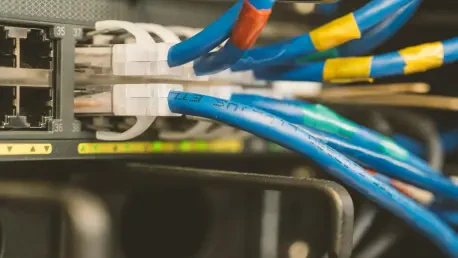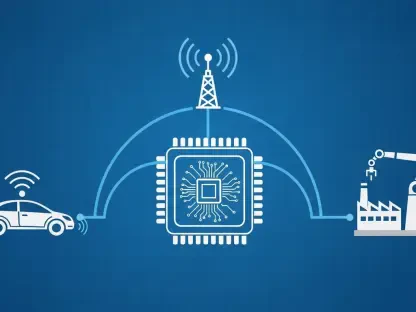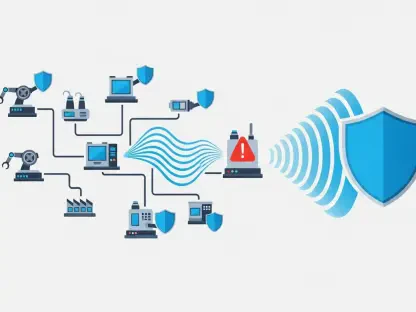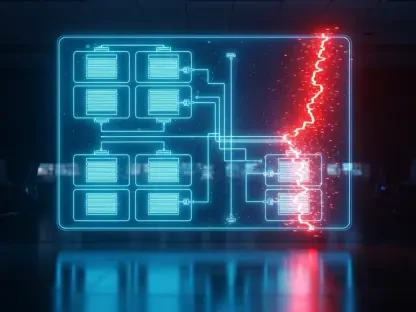In an era where cybersecurity breaches and sophisticated hacking schemes dominate headlines, a surprisingly low-tech crime is wreaking havoc on the cable industry: copper theft. Far from the digital threats often associated with foreign entities or complex malware, this issue involves individuals physically damaging telecom infrastructure to steal copper for quick profit. Brought into sharp focus at the recent SCTE TechExpo 25 conference in Washington, this growing problem is costing cable operators millions while disrupting network reliability for countless subscribers. The financial incentive of copper, which can fetch a decent price at recycling centers, drives much of this vandalism, but the implications extend beyond mere economics. As industry leaders from Charter Communications, Comcast, and the NCTA, alongside law enforcement officials, delve into this challenge, it becomes clear that such theft poses a significant threat to the stability and security of modern communication networks.
Unpacking the Scale of Infrastructure Vandalism
The magnitude of copper theft as a threat to cable networks cannot be overstated, with incidents occurring daily across numerous regions. Unlike isolated cyber incidents, this physical crime directly targets the backbone of telecom infrastructure, cutting into cables on poles or buried underground to extract valuable metal. According to data from the NCTA, over 5,770 intentional acts of theft and vandalism were reported in just a six-month period in 2024, illustrating the alarming frequency of these disruptions. The operational fallout is immediate—service outages can last several hours, sometimes exceeding eight, as technicians scramble to repair the damage. For subscribers, these interruptions translate into frustration and a loss of trust in their service providers, who bear the brunt of accountability for issues beyond their control. This persistent problem underscores a vulnerability in the industry that is as much about physical security as it is about maintaining customer satisfaction in a competitive market.
Beyond the sheer volume of incidents, the scope of copper theft reveals a troubling global trend that transcends borders and industries. While the United States grapples with frequent attacks on telecom lines, similar challenges are reported in countries like Canada and the UK, where even unrelated sectors such as electric vehicle charging stations face cable vandalism for copper. This widespread issue points to a broader societal challenge where the market value of the metal fuels opportunistic crime, often with little regard for the consequences. Notably, the damage isn’t limited to copper-rich cables; fiber-optic lines and wireless towers, which hold no scrap value, are also targeted due to a lack of understanding among thieves. Such misdirected efforts compound the problem, creating unnecessary costs and delays for operators who must restore services critical to communication in both urban and rural communities. The global nature of this crime wave calls for a coordinated response that addresses both local and international dimensions of infrastructure protection.
Financial Incentives and Hidden Motives
At the heart of copper theft lies a straightforward economic driver: the metal’s market value, often around $3 per pound at recycling centers, offers a tempting payout for those willing to risk legal consequences. This financial incentive draws a wide range of perpetrators, from individuals seeking quick cash to organized groups exploiting the scrap metal trade. The ease of selling stolen copper, often with minimal scrutiny at recycling facilities, perpetuates this cycle of crime, making it a low-barrier entry point for illicit gain. Industry experts at the SCTE TechExpo 25 conference highlighted how this economic motivation overshadows the significant downstream effects, such as service disruptions and repair costs, which far outweigh the small profits gained by thieves. Addressing this root cause requires not just punitive measures but also systemic changes to how scrap metal transactions are monitored and regulated across markets.
However, not all incidents of copper theft are purely profit-driven, adding a layer of complexity to the issue. Insights from FBI representatives at the conference revealed that some acts of vandalism carry criminal or political motives aimed at sabotaging communication networks. These intentional disruptions pose a potential national security risk, as they could impair critical infrastructure during emergencies or heighten vulnerabilities in key regions. Unlike the opportunistic thefts driven by financial need, these targeted attacks require a different strategic response, blending law enforcement intelligence with industry safeguards. The dual nature of motives—economic gain versus deliberate harm—complicates mitigation efforts, as solutions must account for both petty criminals and those with more sinister agendas. This multifaceted threat underscores the need for a nuanced approach that goes beyond surface-level deterrence to tackle underlying intentions.
Ripple Effects on Operations and Communities
For cable operators like Charter Communications and Comcast, copper theft translates into a cascade of operational challenges that strain resources and reputation alike. Each incident demands swift action to repair severed lines, often under difficult conditions such as adverse weather or hard-to-access underground sites, with restoration times stretching into hours. The financial burden of these repairs, coupled with the cost of replacing stolen materials, adds up quickly, diverting funds from innovation or network expansion. More critically, these disruptions erode customer confidence, as subscribers experience unexpected outages and delays in service restoration. The pressure to maintain reliability in the face of such unpredictable vandalism places operators in a reactive position, constantly addressing damage rather than proactively enhancing infrastructure, which ultimately hinders long-term growth and service quality.
The societal impact of copper theft extends far beyond corporate balance sheets, affecting entire communities that rely on consistent communication services. In high-risk areas like California, where incidents are particularly frequent, residents and businesses face unreliable access to internet and phone services essential for daily life, work, and emergencies. These interruptions can have profound consequences, from missed critical calls to hampered economic activity, especially in underserved regions where connectivity is already a challenge. The broader implication is a widening digital divide, as repeated disruptions disproportionately affect those least equipped to adapt. This community-level fallout highlights how a seemingly localized crime can ripple outward, undermining the foundational role of telecom networks in modern society and emphasizing the urgency of finding sustainable protections for vulnerable infrastructure.
Barriers to Effective Prevention
Combating copper theft proves to be an uphill battle, largely due to the limitations of traditional law enforcement approaches in addressing this type of property crime. With police resources often prioritized toward violent offenses, incidents of infrastructure vandalism frequently fall lower on the list of actionable cases, leaving cable operators to seek alternative defenses. Industry voices at the conference echoed a sobering reality: arrests alone cannot stem the tide of theft, as the decentralized and opportunistic nature of the crime makes it nearly impossible to catch every perpetrator. This gap in enforcement pushes companies to explore preventive strategies, such as marking cables for traceability or enhancing physical security around vulnerable sites. However, these measures come with their own costs and logistical hurdles, often outpacing the immediate benefits and revealing the need for a broader shift in how such threats are prioritized at a systemic level.
Another significant barrier lies in the scrap metal industry’s lack of stringent oversight, which inadvertently fuels copper theft by providing a ready market for stolen goods. Efforts to educate recyclers about rejecting suspicious materials, such as burnt or stripped wires, have met with mixed success due to inconsistent record-keeping and limited accountability in transactions. While some operators have initiated outreach to communities, including homeless encampments, to clarify that much of their infrastructure lacks valuable metals, the effectiveness of such campaigns varies widely. These educational initiatives, though well-intentioned, struggle against the economic desperation driving many thieves, as well as the anonymity of the scrap trade. Until stronger regulations and collaborative frameworks emerge to close these loopholes, prevention remains a patchwork of partial solutions that fail to fully address the scale of the challenge facing cable networks.
Pathways to Protection Through Technology and Policy
One promising avenue for mitigating copper theft lies in the ongoing transition to fiber-optic networks, which currently account for approximately 94% of many operators’ systems. Unlike copper, fiber holds no scrap value, rendering it an unattractive target for thieves and offering a long-term safeguard for infrastructure security. However, the critical “last mile” connections—often copper lines linking neighborhood nodes to individual homes or buildings—remain vulnerable, as full replacement is a gradual and resource-intensive process. Industry leaders recognize that accelerating this shift to fiber is essential, yet the pace of implementation varies across regions, leaving gaps in protection that thieves continue to exploit. This technological solution, while effective in theory, demands significant investment and time, underscoring the need for interim measures to secure existing networks during the transition.
Parallel to technological advancements, legislative efforts are gaining traction as a means to curb copper theft by targeting the scrap metal market’s role in perpetuating crime. In 24 states, proposed laws aim to increase accountability for recyclers through mandatory documentation and stricter transaction rules, with California’s AB 476 bill standing as a notable example awaiting final approval. Despite the potential of these policies to disrupt the flow of stolen copper, opposition from metal dealers and the slow grind of legislative processes temper expectations for rapid change. The complexity of aligning state-level regulations with industry needs further complicates progress, as does the challenge of enforcing compliance in a fragmented market. While policy reforms represent a critical piece of the puzzle, their impact hinges on overcoming resistance and fostering cooperation between lawmakers, operators, and recyclers to create a unified front against infrastructure vandalism.
Building a Collaborative Defense Strategy
Addressing copper theft demands a collective effort that bridges the diverse perspectives and capabilities of multiple stakeholders, from cable operators to law enforcement and beyond. Companies like Charter and Comcast focus on immediate service restoration and customer retention, bearing the direct costs of vandalism while advocating for practical deterrents like community education. Meanwhile, industry groups such as CableLabs push for long-term technological upgrades, emphasizing the shift to fiber as a definitive solution. The FBI introduces a national security lens, raising concerns about politically motivated disruptions that could escalate risks during critical times. This spectrum of priorities illustrates the complexity of the issue, where no single entity holds all the answers, and success depends on aligning operational, strategic, and regulatory goals to form a cohesive defense against a pervasive threat.
Ultimately, the path forward requires a blend of innovation, policy reform, and cross-sector collaboration to tackle both the symptoms and root causes of copper theft. Encouraging recyclers to adopt stricter standards, accelerating fiber deployment, and fostering dialogue between communities and industry players are all vital steps in reducing the incidence of vandalism. Economic factors driving theft, such as poverty or lack of opportunity, also warrant attention through broader social initiatives that address underlying motivations. By weaving together these diverse threads—technology, legislation, education, and community engagement—a more resilient framework can emerge to protect cable networks. Reflecting on past efforts at the SCTE TechExpo 25 conference, stakeholders demonstrated a commitment to evolving strategies, setting the stage for future advancements in safeguarding critical infrastructure against this persistent and disruptive crime.









